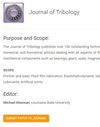Uncertainty Analysis of Friction and Wear Rate of Cylinder Liner- Piston Ring Tribo Pair under Boundary Lubrication Conditions
IF 3
3区 工程技术
Q2 ENGINEERING, MECHANICAL
引用次数: 0
Abstract
Abstract Uncertainty analyses can improve the reliability and validity of the assessment of friction and wear rate of tribo-systems. This work analyses the various sources of uncertainty in the estimation of friction and wear rate of liner-ring pairs using a linear reciprocating tribometer (LRT) as per the analytical method suggested by Guide to the Expression of Uncertainty in Measurement (GUM) and simulation approach using Monte Carlo Simulation (MCS) method. The uncertainty analysis was conducted by performing sliding wear experiments using a hypereutectic Al-Si cylinder liner specimen against the chrome-coated piston ring as the counter specimen. The experiments were performed to mimic the engine's condition under a boundary layer lubrication regime. The Type A and Type B uncertainty components of the tribo system, such as uncertainty involved in the measurement of mass, linear dimensions of the specimen, radius of the specimen, normal force, stroke length and frictional force, were evaluated to study their influence on the assessment of the friction and wear rate. The probability density function of all these uncertainty sources were simulated using MCS approach to compute the 95% coverage interval for friction and wear rate directly. The variation in absolute value between the coverage interval limits computed by the GUM framework and predicted by the Monte Carlo method for wear rate was 11.83%, and for friction coefficient, it was 12.005%.边界润滑条件下缸套-活塞环摩擦副摩擦磨损率的不确定性分析
摘要不确定性分析可以提高摩擦系统摩擦磨损率评估的可靠性和有效性。本文根据《测量不确定度表达指南》(GUM)和蒙特卡罗模拟(MCS)方法提出的分析方法,分析了线性往动式摩擦计(LRT)估计衬里环副摩擦和磨损率的各种不确定度来源。采用过共晶Al-Si缸套试样与镀铬活塞环作为反试样进行滑动磨损实验,进行了不确定度分析。实验模拟了发动机在边界层润滑状态下的工况。评估了摩擦系统中质量、试样线性尺寸、试样半径、法向力、行程长度和摩擦力测量所涉及的A类和B类不确定度分量,研究了它们对摩擦磨损率评估的影响。采用MCS方法模拟所有不确定性源的概率密度函数,直接计算摩擦磨损率的95%覆盖区间。GUM框架计算的磨损率覆盖区间极限绝对值与蒙特卡罗方法预测的磨损率覆盖区间极限绝对值的差异为11.83%,摩擦系数绝对值的差异为12.005%。
本文章由计算机程序翻译,如有差异,请以英文原文为准。
求助全文
约1分钟内获得全文
求助全文
来源期刊
CiteScore
4.20
自引率
12.00%
发文量
117
审稿时长
4.1 months
期刊介绍:
The Journal of Tribology publishes over 100 outstanding technical articles of permanent interest to the tribology community annually and attracts articles by tribologists from around the world. The journal features a mix of experimental, numerical, and theoretical articles dealing with all aspects of the field. In addition to being of interest to engineers and other scientists doing research in the field, the Journal is also of great importance to engineers who design or use mechanical components such as bearings, gears, seals, magnetic recording heads and disks, or prosthetic joints, or who are involved with manufacturing processes.
Scope: Friction and wear; Fluid film lubrication; Elastohydrodynamic lubrication; Surface properties and characterization; Contact mechanics; Magnetic recordings; Tribological systems; Seals; Bearing design and technology; Gears; Metalworking; Lubricants; Artificial joints

 求助内容:
求助内容: 应助结果提醒方式:
应助结果提醒方式:


